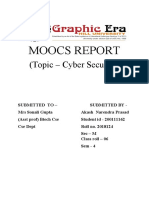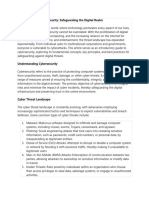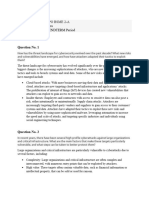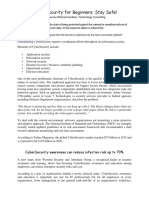The Importance of Cybersecurity in The Digital Age
The Importance of Cybersecurity in The Digital Age
Uploaded by
savke.vekiCopyright:
Available Formats
The Importance of Cybersecurity in The Digital Age
The Importance of Cybersecurity in The Digital Age
Uploaded by
savke.vekiOriginal Title
Copyright
Available Formats
Share this document
Did you find this document useful?
Is this content inappropriate?
Copyright:
Available Formats
The Importance of Cybersecurity in The Digital Age
The Importance of Cybersecurity in The Digital Age
Uploaded by
savke.vekiCopyright:
Available Formats
The Importance of Cybersecurity in the Digital Age
Introduction
As the world becomes increasingly digital, cybersecurity has emerged as a critical
concern for individuals, businesses, and governments. The rise of cyber threats,
including data breaches, ransomware, and identity theft, underscores the importance of
robust cybersecurity measures. This essay examines the key aspects of cybersecurity, the
challenges faced, and strategies to enhance digital security.
Key Aspects of Cybersecurity
Cybersecurity involves protecting digital systems, networks, and data from unauthorized
access, attacks, and damage.
1. Data Protection Ensuring the confidentiality, integrity, and availability of data is
a core component of cybersecurity. Encryption, access controls, and secure data
storage are essential measures to protect sensitive information from breaches
and leaks.
2. Network Security Protecting network infrastructure from cyber attacks involves
implementing firewalls, intrusion detection systems, and secure network
protocols. Network security aims to prevent unauthorized access and ensure the
safe transmission of data.
3. Endpoint Security Devices such as computers, smartphones, and IoT devices are
vulnerable points of entry for cyber threats. Endpoint security involves deploying
antivirus software, endpoint detection and response (EDR) solutions, and regular
security updates to protect these devices.
4. Identity and Access Management (IAM) IAM systems ensure that only
authorized users can access certain resources. Techniques such as multi-factor
authentication (MFA), single sign-on (SSO), and role-based access control (RBAC)
help manage user identities and permissions effectively.
5. Incident Response and Recovery Preparing for and responding to cybersecurity
incidents is crucial. Incident response plans, regular drills, and disaster recovery
strategies help organizations mitigate the impact of cyber attacks and restore
normal operations swiftly.
Challenges in Cybersecurity
Despite advancements in cybersecurity technologies, several challenges persist in
safeguarding digital environments.
1. Evolving Threat Landscape Cyber threats are continuously evolving, with
attackers employing increasingly sophisticated techniques. Keeping up with the
latest threats and vulnerabilities is a constant challenge for cybersecurity
professionals.
2. Human Factors Human error remains a significant vulnerability in cybersecurity.
Phishing attacks, weak passwords, and inadequate security awareness can
compromise even the most robust security systems. Ongoing training and
awareness programs are essential to mitigate human-related risks.
3. Resource Constraints Many organizations, particularly small and medium-sized
enterprises (SMEs), face resource constraints in implementing comprehensive
cybersecurity measures. Limited budgets, lack of expertise, and insufficient
staffing can hinder effective cybersecurity practices.
4. Compliance and Regulation Navigating the complex landscape of cybersecurity
regulations and standards can be challenging. Organizations must ensure
compliance with laws such as the General Data Protection Regulation (GDPR) and
the Health Insurance Portability and Accountability Act (HIPAA) while maintaining
operational efficiency.
5. Integration and Complexity The integration of diverse IT systems and
applications can create security vulnerabilities. Ensuring seamless and secure
integration, especially in large organizations with complex IT environments, is a
significant challenge.
Strategies to Enhance Cybersecurity
To address these challenges and strengthen cybersecurity, organizations can adopt
several strategies.
1. Risk Assessment and Management Conducting regular risk assessments helps
identify and prioritize potential security threats. Implementing risk management
frameworks, such as the NIST Cybersecurity Framework, provides a structured
approach to mitigating identified risks.
2. Investment in Security Technologies Investing in advanced cybersecurity
technologies, such as artificial intelligence and machine learning, enhances threat
detection and response capabilities. Automation and orchestration tools can
streamline security operations and improve efficiency.
3. Security Awareness and Training Promoting a culture of security awareness
through regular training and education programs is crucial. Employees should be
educated on recognizing phishing attempts, using strong passwords, and
following best practices for data protection.
4. Collaboration and Information Sharing Collaboration and information sharing
among organizations, industries, and government agencies enhance collective
cybersecurity resilience. Participating in threat intelligence sharing platforms and
industry-specific security forums helps organizations stay informed about
emerging threats.
5. Continuous Monitoring and Improvement Cybersecurity is an ongoing process
that requires continuous monitoring, assessment, and improvement. Regular
security audits, vulnerability assessments, and penetration testing help identify
and address weaknesses in security posture.
Conclusion
In the digital age, cybersecurity is essential for protecting data, systems, and users from
an ever-evolving landscape of cyber threats. By understanding the key aspects of
cybersecurity, addressing the challenges, and implementing effective strategies,
organizations can enhance their digital security and build resilience against cyber
attacks. As technology continues to advance, a proactive and adaptive approach to
cybersecurity will be crucial in safeguarding the digital future.
You might also like
- Moocs Report: (Topic - Cyber Security)Document11 pagesMoocs Report: (Topic - Cyber Security)Akash PrasadNo ratings yet
- Cyber Security PDFDocument16 pagesCyber Security PDFSucharita Sarkar100% (1)
- CybersecurityDocument3 pagesCybersecurityKanumathireddy SaimaniNo ratings yet
- Computer ReportDocument4 pagesComputer Reportlaiqamalik09No ratings yet
- CT Report2Document38 pagesCT Report2narayan.barmanNo ratings yet
- Ensuring Robust Security and Privacy in Today's Digital LandscapeDocument11 pagesEnsuring Robust Security and Privacy in Today's Digital LandscapeSundari KaliNo ratings yet
- Cyber SecurityDocument2 pagesCyber SecurityGedion KiptanuiNo ratings yet
- The Essential Landscape of CybersecurityDocument4 pagesThe Essential Landscape of Cybersecurityijlal.ashrafNo ratings yet
- Cybersecurity AwarenessDocument4 pagesCybersecurity Awarenessanthonylrush4No ratings yet
- Information Security Governance: What, How and Why of IS SecurityDocument8 pagesInformation Security Governance: What, How and Why of IS SecurityAmit Kumar GuptaNo ratings yet
- Network SecurityDocument3 pagesNetwork SecurityKanumathireddy SaimaniNo ratings yet
- Lecture 1 and 2Document10 pagesLecture 1 and 2Dessa Joy Dela CruzNo ratings yet
- حاسبDocument15 pagesحاسبxnrm7jg676No ratings yet
- Cybersecurity Strategies For Businesse White Paper-1Document12 pagesCybersecurity Strategies For Businesse White Paper-1Hershey JawandaNo ratings yet
- ch1 IntroductionDocument3 pagesch1 Introductionchandu06ashaNo ratings yet
- Enhancing CybersecurityDocument2 pagesEnhancing Cybersecuritysevda sarginNo ratings yet
- Esearch On CybersecurityDocument2 pagesEsearch On Cybersecuritysaadrasheed828No ratings yet
- Cyber Security Process and TechnologiesDocument8 pagesCyber Security Process and TechnologiesSyeda Narjis BatoolNo ratings yet
- Fundamental of Computer SecurityDocument8 pagesFundamental of Computer SecuritymichealNo ratings yet
- Living in The It Era Unit Iiiiv 1Document22 pagesLiving in The It Era Unit Iiiiv 1acegolong143No ratings yet
- Slidesgo Fortifying Digital Frontiers An in Depth Exploration of Cyber Security Strategies 20241024143838lve5Document13 pagesSlidesgo Fortifying Digital Frontiers An in Depth Exploration of Cyber Security Strategies 20241024143838lve5prasen3110No ratings yet
- Cyber SecurityDocument3 pagesCyber SecurityBae BaeNo ratings yet
- Cybersecurity ArticleDocument2 pagesCybersecurity ArticleKhushi SampatNo ratings yet
- Generic Q1-82Document26 pagesGeneric Q1-82oobidoo916No ratings yet
- Questions 1 - 39Document14 pagesQuestions 1 - 39oobidoo916No ratings yet
- CYBER SECURITY Ultimate Beginners Guide To Learn The Basics and Effective Methods of CyberDocument106 pagesCYBER SECURITY Ultimate Beginners Guide To Learn The Basics and Effective Methods of Cybervincent laneNo ratings yet
- Cyber SecurityDocument16 pagesCyber Securityblessingigbo4No ratings yet
- Cyber Security IntroductionDocument4 pagesCyber Security IntroductionRENE STEPHEN VISHAL M VNo ratings yet
- Cyber SecurityDocument20 pagesCyber SecurityHarine ASNo ratings yet
- ICT502 S1 2024 Research EssayDocument16 pagesICT502 S1 2024 Research Essayagneschan4433No ratings yet
- Overview of Safety and SecurityDocument8 pagesOverview of Safety and SecurityRalph ArkorfulNo ratings yet
- CybersecurityDocument20 pagesCybersecuritydev.akb1234No ratings yet
- Assignment2 TorreecampoDocument6 pagesAssignment2 TorreecampoAllan TorrecampoNo ratings yet
- Rewrite Article With Keywords 2 13 2024 12 39 39 PMDocument4 pagesRewrite Article With Keywords 2 13 2024 12 39 39 PMbh.rautelaNo ratings yet
- Part 2 CyberDocument10 pagesPart 2 Cyberjmutongu90No ratings yet
- A Definition of Cyber SecurityDocument5 pagesA Definition of Cyber SecurityShubhranshu pandeyNo ratings yet
- Information Assurance and SecurityDocument5 pagesInformation Assurance and SecuritymatiostsintaNo ratings yet
- What Is Cyber SecurityDocument56 pagesWhat Is Cyber SecurityHumayoun SaeedNo ratings yet
- Attack Prevention TechniquesDocument9 pagesAttack Prevention TechniquesLavanya AlagNo ratings yet
- .Strengthening Cybersecurity A Comprehensive Strategy For XYZ LTD .Document5 pages.Strengthening Cybersecurity A Comprehensive Strategy For XYZ LTD .marypkagoNo ratings yet
- Security Training: Business Continuity and Disaster RecoveryDocument3 pagesSecurity Training: Business Continuity and Disaster RecoveryAnonymous XmvR2K6No ratings yet
- Defending the Digital Perimeter: Network Security Audit Readiness StrategiesFrom EverandDefending the Digital Perimeter: Network Security Audit Readiness StrategiesNo ratings yet
- Introduction To Recent Data Security TrendsDocument10 pagesIntroduction To Recent Data Security Trendsaarche027No ratings yet
- SJK CYBER SecurityDocument25 pagesSJK CYBER SecuritySwaleha Javed KhanNo ratings yet
- Policies To Mitigate Cyber RiskDocument7 pagesPolicies To Mitigate Cyber Risksushilsona789No ratings yet
- The Need For Information SecurityDocument34 pagesThe Need For Information Securitybartolaba.ruzhanne96No ratings yet
- Introduction To CybersecurityDocument9 pagesIntroduction To Cybersecuritydhruvbhanushali40689No ratings yet
- Running Head: CYBERSECURITY 1Document11 pagesRunning Head: CYBERSECURITY 1Tonnie KiamaNo ratings yet
- SP1 Chapter 3Document9 pagesSP1 Chapter 3Jaslen MagalongNo ratings yet
- Sample ResearchDocument10 pagesSample ResearchAlbert Malabad Jr.No ratings yet
- Ias IiDocument34 pagesIas IimodestoalmajeanNo ratings yet
- 146.editedDocument11 pages146.editedTonnie KiamaNo ratings yet
- The Importance of Cybersecurity in The Digital AgeDocument2 pagesThe Importance of Cybersecurity in The Digital Ageiconline701No ratings yet
- Cyber Security Digital Forensics WorkDocument6 pagesCyber Security Digital Forensics Workokware brianNo ratings yet
- Cybersecurity Fundamentals - Module 10Document5 pagesCybersecurity Fundamentals - Module 10joelyrics9No ratings yet
- Cyber Security IntroductionDocument10 pagesCyber Security IntroductionRitesh KelkarNo ratings yet
- Introduction To Information SecurityDocument11 pagesIntroduction To Information Securityroneycruz.govticNo ratings yet
- Cyber Security For Beginners: Stay Safe!: Define CybersecurityDocument4 pagesCyber Security For Beginners: Stay Safe!: Define CybersecurityRima SadekNo ratings yet
- Ict 1Document4 pagesIct 1isihakayuxufuNo ratings yet
- 6th RN Kao Memorial Lecture by Naresh ChandraDocument12 pages6th RN Kao Memorial Lecture by Naresh ChandraCanary TrapNo ratings yet
- Online Examination SystemDocument6 pagesOnline Examination SystemAyan SarkarNo ratings yet
- Samba 4Document3 pagesSamba 4Alejandro Òkànràn SodeNo ratings yet
- SSL Certificate Renewal AutomationDocument4 pagesSSL Certificate Renewal Automationshashankmharse1533No ratings yet
- Applications of MathematicsDocument35 pagesApplications of MathematicsRamdas Sonawane100% (1)
- How To InstallDocument2 pagesHow To InstallumaNo ratings yet
- Designing Block Ciphers - DES: Dhiren PatelDocument37 pagesDesigning Block Ciphers - DES: Dhiren PatelSudha PatelNo ratings yet
- 10.2.1.9 Lab - Configure A Site-to-Site IPsec VPN Using ISR CLI and ASA 5505 ASDM - InstructorDocument36 pages10.2.1.9 Lab - Configure A Site-to-Site IPsec VPN Using ISR CLI and ASA 5505 ASDM - Instructorcheicktest1No ratings yet
- Cisco - Testinises.350 701.free - pdf.2021 Mar 12.by - Gary.145q.vceDocument15 pagesCisco - Testinises.350 701.free - pdf.2021 Mar 12.by - Gary.145q.vcedropboxNo ratings yet
- Lav TeamDocument4 pagesLav Teamluisgeologo0% (1)
- Captcha As Graphical Passwords-A New Security Primitive Based On Hard AI ProblemsDocument5 pagesCaptcha As Graphical Passwords-A New Security Primitive Based On Hard AI ProblemsAbdul RazzakNo ratings yet
- Training-Catalogue Grcmentor PDFDocument2 pagesTraining-Catalogue Grcmentor PDFteja769No ratings yet
- Use of Artificial Intelligence Techniques / Applications in Cyber DefenseDocument6 pagesUse of Artificial Intelligence Techniques / Applications in Cyber DefenseAsher AlexanderNo ratings yet
- Hackingdemystified Com Mitm Attack Using SslstripDocument8 pagesHackingdemystified Com Mitm Attack Using SslstripProDev McNo ratings yet
- Cryptographic Hash FunctionDocument15 pagesCryptographic Hash FunctionIchitsukiNo ratings yet
- Dopra Linux OS Security (SingleRAN - 18)Document53 pagesDopra Linux OS Security (SingleRAN - 18)smartemNo ratings yet
- NitroView ESM ELM DatasheetDocument7 pagesNitroView ESM ELM DatasheetbxdmikeNo ratings yet
- Validation For A Login PageDocument2 pagesValidation For A Login PageAmal RajNo ratings yet
- CisspDocument16 pagesCisspRyan GlasgowNo ratings yet
- Review On Bastion Hosts: G.Vijayababu, D.Haritha, R.Satya PrasadDocument8 pagesReview On Bastion Hosts: G.Vijayababu, D.Haritha, R.Satya PrasadMalika AsimNo ratings yet
- DevOps Jumpstarting-Your-DevSecOps Jeff-Williams AppSecEU2018Document37 pagesDevOps Jumpstarting-Your-DevSecOps Jeff-Williams AppSecEU2018Renaud Louis DahouNo ratings yet
- Kaspersky Key and InstructionDocument4 pagesKaspersky Key and InstructionAlif Aikal Che HatNo ratings yet
- s1 Datasheet Singularity Platform enDocument2 pagess1 Datasheet Singularity Platform enPutra BagusNo ratings yet
- Keys For @letsdoreviewsDocument2 pagesKeys For @letsdoreviewsKashif JavedNo ratings yet
- Dec50113q - Set 1 - NazuraDocument3 pagesDec50113q - Set 1 - NazuraEryan HeryanShah Qiu QiuNo ratings yet
- Cyber Security and Cyber Laws Practical ListDocument2 pagesCyber Security and Cyber Laws Practical Listnahec84577No ratings yet
- MIT Report IPRI CIS Critical InfrastructureDocument49 pagesMIT Report IPRI CIS Critical InfrastructureTechCrunchNo ratings yet
- Cybercrime Presentation PDFDocument42 pagesCybercrime Presentation PDFRajashri HankareNo ratings yet
- Sec Sec For Vpns W Ipsec 15 MT Book PDFDocument168 pagesSec Sec For Vpns W Ipsec 15 MT Book PDFcrnaupaNo ratings yet
- Guo2011 Chapter ThePHOTONFamilyOfLightweightHaDocument18 pagesGuo2011 Chapter ThePHOTONFamilyOfLightweightHashahidNo ratings yet

























































































